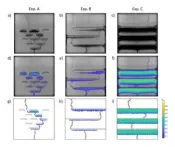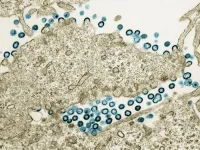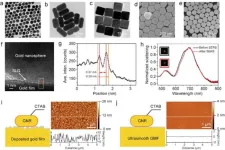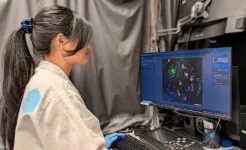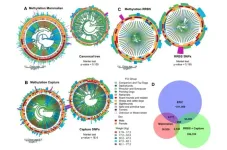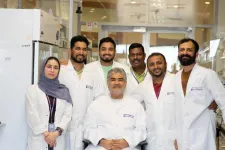(Press-News.org) Scientists at Sanford Burnham Prebys, University of California San Diego and their international collaborators have reported that more types of lung cells can be infected by SARS-CoV-2 than previously thought, including those without known viral receptors. The research team also reported for the first time that the lung is capable of independently mustering an inflammatory antiviral response without help from the immune system when exposed to SARS-CoV-2.
This work is especially timely, as cases of COVID-19 are on the rise in the scientists’ hometown of San Diego during a summertime spike. Looking beyond the region, more than half of the states in the country have reported “very high” or “high” levels of infection, according to the Centers for Disease Control and Prevention.
“Headlines have come and gone, but SARS-CoV-2 and COVID-19 have never left,” says Evan Snyder, MD, PhD, director of the Center for Stem Cells and Regenerative Medicine and a professor in the Human Genetics Program at Sanford Burnham Prebys. “And neither have the scientists studying it.”
“While many people experience mild or moderate symptoms, COVID-19 still kills,” adds Sandra Leibel, MD, MSc, a neonatologist at Rady Children's Hospital-San Diego and an associate professor of Pediatrics at UC San Diego School of Medicine. “This virus is here to stay, and we need to learn everything we can about it so we can improve treatment and prevention.”
Leibel, Snyder and their collaborators reported their new discoveries about SARS-CoV-2 and COVID-19 in a paper published July 19, 2024, in PNAS. The scientists used a technique to transform cells taken from patients into cells resembling stem cells. These embryonic-like cells—known as induced pluripotent stem cells (iPSCs)—can then be turned into other types of human cells. The team caused them to develop into a grouping of various lung cell types in a pattern that mimics the human lung at a smaller scale.
“With most models for studying respiratory infections, you can't isolate a specific cellular response because you have all the immune system cells rushing in to help deal with the invaders,” notes Snyder.
“Using our lung organoids or ‘mini lungs,’ another benefit is that we can choose the sex of the cells so we're not just studying male-dominant or female-dominant lung tissue,” adds Leibel. “This is important, as we know that the lung responds differently during disease if you're a female or a male.” In addition, the team could make iPSCs from patients of different racial and ethnic groups to try to understand the known disparity in this and other diseases—both in terms of susceptibility to infection, severity of the consequences, and responsiveness to various medications.
The scientists observed that SARS-CoV-2 was able to acutely infect many previously undescribed cell types in the mini lungs. This held true when testing different strains of SARS-CoV-2, although it was clear that certain strains were more effective at infecting specific cell types.
“People used to say that SARS-CoV-2 only infects cells with certain receptors, especially those with the ACE2 receptor known to interact with the infamous SARS-CoV-2 spike protein,” says Snyder. “We demonstrated that when a direct entry point was unavailable, the virus just punches through the cell membrane instead.”
“With the Delta variant having produced more severe symptoms, and the Omicron variant being less deadly but more contagious, we hypothesized that Delta may prefer the alveolar cells deeper in the lungs, while Omicron sticks more to the upper airways,” adds Leibel. “While all strains were capable of infecting many lung cell types, we did see a distinct preference for these strains, as predicted.” In fact, as the strains changed over time, the scientists could see what was reported in patients as the character of the pandemic changed. Earlier strains such as Delta caused more deadly pneumonias because they affected lower lung cells. Later strains like Omicron affected more upper lung cells and led to clinicians seeing fewer pneumonias and more airway problems and sore throats. So, the mini-lung system may help the team predict patient outcomes.
In addition to demonstrating how the virus infects cells previously thought to be safe, the scientists also found a way to block the virus’s unexpected flanking maneuver. The team demonstrated that apilimod—a drug currently being studied for potentially treating cancer, ALS, dementia and various viral infections—effectively blocked the backdoor entry of SARS-CoV-2 into cells lacking traditional entry points.
“Our data suggest that apilimod could be an adjunct therapy given early on to slow down the infection and enhance the effectiveness of other medicines and the innate immune response,” says Snyder.
In another surprising result, Leibel, Snyder and team discovered that the mini lungs have their own intrinsic “first response” system in reaction to sensing SARS-CoV-2. Even though the mini lungs lack any connection to an immune system, this study shows that lung cells can initiate many of the same biologic and cell signaling changes in response to a viral threat that are observed when the immune system is present.
“We found that lung cells are capable of autonomously reacting to infection immediately while also subsequently calling for reinforcements from the immune system,” adds Snyder.
“We showed that it’s not just the immune cells that are becoming over-activated and secreting too much of the pro-inflammatory cytokines that contribute to severe cases of COVID-19,” says Leibel. “The lung cells do this as well.”
The scientists learned that this inherent antiviral response system in the mini lungs was orchestrated by an unlikely source: one of the four proteins that mix with fats to form a soapy substance in the lungs’ air sacs that helps keep them open as we breathe. This detergent-like substance is called surfactant, and its constituent protein surfactant protein B (SP-B) turned out to be the most important player in the mini lungs’ attempts to ward off SARS-CoV-2. No prior research had suggested that SP-B played any cellular signaling roles.
“When we tested mini lungs genetically engineered to not express SP-B, we saw triple the number of cells infected with SARS-CoV-2,” says Leibel. “When we followed that up by treating these engineered mini lungs with SP-B in a similar way to how premature newborns with surfactant deficiency are treated, we noted a reduction in viral infectivity.”
“These findings suggest not just one but two potential novel drug applications with the possible clinical use of surfactant early in COVID-19 cases,” adds Snyder. “This is important, as we only have two current proven antiviral drugs in Paxlovid and remdesivir.”
The team plans to follow up these findings with studies to determine exactly how surfactant is so effective at protecting cells against viral invasion. Also, they are investigating whether a rapid test for SP-B as well as certain characteristic pro-inflammatory cytokines may help quickly determine which people are at greater risk of more severe forms of COVID-19.
Leibel adds, “This would help people make more informed decisions about traveling and attending public events during spikes of COVID-19, and it also would help physicians tailor treatments for those at an increased risk of serious disease.”
Additional authors on the study include Rachael N. McVicar, Rabi Murad, Elizabeth M. Kwong, Alex E. Clark, Asuka Alvarado, Bethany A. Grimmig, Ruslan Nuryyev, Randee E. Young, Jamie C. Lee, Weiqi Peng, Yanfang P. Zhu, Eric Griffis, Cameron J. Nowell, Brian James, Suzie Alarcon, Atul Malhotra, Linden J. Gearing, Paul J. Hertzog, Cheska M. Galapate, Koen M. O. Galenkamp, Cosimo Commisso, Davey M. Smith, Xin Sun, Aaron F. Carlin, Richard L. Sidman and Ben A. Croker.
The study was supported by the California Institute of Regenerative Medicine (DISC2COVID19-12022); the United States – Israel Binational Science Foundation (2017176); the American Asthma Foundation; the National Institutes of Health (AI036214); the National Cancer Institute (COVID-19 supplement to 3R01CA207189-05S1); the National Institutes of Health Shared Instrumentation Grant (S10 OD026929); and the Richmond Family Fund.
The study’s DOI is 10.1073/pnas.24081091.
END
Mini lungs make major COVID-19 discoveries possible
Scientists infect miniature lung organoids with the virus responsible for COVID-19, revealing new ways in which the infection spreads and suggesting potential treatments
2024-07-23
ELSE PRESS RELEASES FROM THIS DATE:
Exploratory analysis associates HIV drug abacavir with elevated cardiovascular disease risk in large global trial
2024-07-23
WHAT:
Current or previous use of the antiretroviral drug (ARV) abacavir was associated with an elevated risk of major adverse cardiovascular events (MACE) in people with HIV, according to an exploratory analysis from a large international clinical trial primarily funded by the National Institutes of Health (NIH). There was no elevated MACE risk for the other antiretroviral drugs included in the analysis. The findings will be presented at the 2024 International AIDS Conference (AIDS 2024) in Munich, Germany.
The Randomized Trial to Prevent Vascular Events in HIV (REPRIEVE) enrolled 7,769 study participants with HIV from 12 countries that found ...
Control of light–matter interactions in two-dimensional materials with nanoparticle-on-mirror structures
2024-07-23
A new publication from Opto-Electronic Sciences; DOI 10.29026/oes.2024.230051 , discusses control of light–matter interactions in two-dimensional materials with nanoparticle-on-mirror structures.
With the rapid development of high bit-rate wireless services driven by mobile internet, AI computing, high-definition videos, virtual reality/augmented reality (VAR) applications, and so on, the demand for wireless data rates has grown explosively in the past decades1, 2. Supporting such fast data rate at tens of Gbit/s pushes the carrier frequency to the THz (0.1-10 THz) ...
Does the onset of daylight saving time lead to an unhealthy lifestyle?
2024-07-23
Researchers from North Carolina State University, University of Manitoba, Bern University of Applied Sciences, University of South Carolina, and California Baptist University published a new Journal of Marketing study that explores whether the onset of daylight saving time leads consumers to engage in unhealthy behaviors.
The study, forthcoming in the Journal of Marketing, is titled “Spring Forward = Fall Back? The Effect of Daylight Saving Time Change on Consumers’ Unhealthy Behavior” and is authored by Ramkumar Janakiraman, Harsha ...
Best Paper awards lack transparency and do not increase equitability
2024-07-23
Research awards are an integral part of the universal “prestige economy” in science, but do they incentivize greater transparency, inclusivity, and openness? This study uses cross-disciplinary data to explore the level of transparency of publicly available award descriptions and assessment criteria, asking whether such awards contribute to or propagate existing reproducibility crises and inequities in science.
#####
In your coverage, please use this URL to provide access to the freely available paper in PLOS Biology: http://journals.plos.org/plosbiology/article?id=10.1371/journal.pbio.3002715
Article ...
Brain’s support cells contribute to Alzheimer’s disease by producing toxic peptide
2024-07-23
Oligodendrocytes are an important source of amyloid beta (Aβ) and play a key role in promoting neuronal dysfunction in Alzheimer’s disease (AD), according to a study published July 23, 2024 in the open-access journal PLOS Biology by Rikesh Rajani and Marc Aurel Busche from the UK Dementia Research Institute at University College London, and colleagues.
AD is a devastating neurodegenerative disorder affecting millions of people worldwide. Accumulation of Aβ – peptides consisting of 36 to 43 amino acids – ...
Co-analysis of methylation platforms for signatures of biological aging in the domestic dog
2024-07-23
“In this study, we explore the potential of the three largest, publicly available DNA methylation datasets in dogs to identify signals of biological age.”
BUFFALO, NY- July 23, 2024 – A new research paper was published in Aging (listed by MEDLINE/PubMed as "Aging (Albany NY)" and "Aging-US" by Web of Science) Volume 16, Issue 13, entitled, “Co-analysis of methylation platforms for signatures of biological aging in the domestic dog reveals previously unexplored confounding factors.”
Chronological age reveals the number of years an individual has lived since birth. By contrast, biological age varies between individuals of the same chronological ...
Mass layoffs and data breaches could be connected, according to researchers
2024-07-23
BINGHAMTON, N.Y. -- A research team led by faculty from Binghamton University, State University of New York has been exploring how mass layoffs and data breaches could be connected. Their theory: since layoffs create conditions where disgruntled employees face added stress or job insecurity, they are more likely to engage in risky behaviors that heighten the company’s vulnerability to data breaches.
The research, outlined in a paper titled “The Impacts of Layoffs Announcement on Cybersecurity Breaches,” was presented by Binghamton ...
How does the brain respond to sleep apnea?
2024-07-23
Nearly 40 million adults in the U.S. have sleep apnea, and more than 30 million of them use a continuous positive airway pressure (CPAP) machine while sleeping. However, the machines tend to be expensive, clunky and uncomfortable — resulting in many users giving up on using them.
High blood pressure is often linked with sleep apnea because the brain works harder to regulate blood flow and breathing during sleep. A recent study at the University of Missouri offers new insight into the underlying mechanisms within the brain contributing ...
NYU Abu Dhabi researchers discover tumor suppressor protein Par-4 triggers unique cell death pathway in cancerous cells
2024-07-23
Abu Dhabi, July 22, 2024: A team of researchers at NYU Abu Dhabi, led by Professor Sehamuddin Galadari, has discovered that the tumor suppressor protein Prostate apoptosis response-4 (Par-4) can cause a unique type of cell death called ferroptosis in human glioblastoma – the most common and aggressive type of brain tumor – while sparing healthy cells. This new understanding has the potential to inform the development of novel treatments for various hard-to-treat cancers and neurodegenerative diseases.
Ferroptosis is triggered by the iron-mediated production of reactive ...
Donald Lloyd-Jones, MD, ScM, chosen to lead BU/NHLBI’s Framingham Heart Study, BU/BMC Department of Medicine Section of Preventive Medicine
2024-07-23
(BOSTON) – Donald M. Lloyd-Jones, MD, ScM, has accepted the position of director of the Framingham Center for Population and Prevention Science, principal investigator of the Framingham Heart Study, and chief of the section of preventive medicine within the department of medicine at the Chobanian & Avedisian School of Medicine and Boston Medical Center, effective January 1, 2025.
Lloyd-Jones is the chair of preventive medicine and Eileen M. Foell Professor of Heart Research and professor of preventive medicine, medicine and pediatrics at Northwestern University. He previously served as senior associate dean for clinical and translational ...
LAST 30 PRESS RELEASES:
Researchers uncover axonal protein synthesis defect in ALS
Why are men more likely to develop multiple myeloma than women?
Smartphone-based interventions show promise for reducing alcohol and cannabis use: New research
How do health care professionals determine eligibility for MAiD?
Microplastics detected in rural woodland
JULAC and Taylor & Francis sign open access agreement to boost the impact of Hong Kong research
Protecting older male athletes’ heart health
KAIST proposes AI-driven strategy to solve long-standing mystery of gene function
Eye for trouble: Automated counting for chromosome issues under the microscope
The vast majority of US rivers lack any protections from human activities, new research finds
Ultrasound-responsive in situ antigen "nanocatchers" open a new paradigm for personalized tumor immunotherapy
Environmental “superbugs” in our rivers and soils: new one health review warns of growing antimicrobial resistance crisis
Triple threat in greenhouse farming: how heavy metals, microplastics, and antibiotic resistance genes unite to challenge sustainable food production
Earthworms turn manure into a powerful tool against antibiotic resistance
AI turns water into an early warning network for hidden biological pollutants
Hidden hotspots on “green” plastics: biodegradable and conventional plastics shape very different antibiotic resistance risks in river microbiomes
Engineered biochar enzyme system clears toxic phenolic acids and restores pepper seed germination in continuous cropping soils
Retail therapy fail? Online shopping linked to stress, says study
How well-meaning allies can increase stress for marginalized people
Commercially viable biomanufacturing: designer yeast turns sugar into lucrative chemical 3-HP
Control valve discovered in gut’s plumbing system
George Mason University leads phase 2 clinical trial for pill to help maintain weight loss after GLP-1s
Hop to it: research from Shedd Aquarium tracks conch movement to set new conservation guidance
Weight loss drugs and bariatric surgery improve the body’s fat ‘balance:’ study
The Age of Fishes began with mass death
TB harnesses part of immune defense system to cause infection
Important new source of oxidation in the atmosphere found
A tug-of-war explains a decades-old question about how bacteria swim
Strengthened immune defense against cancer
Engineering the development of the pancreas
[Press-News.org] Mini lungs make major COVID-19 discoveries possibleScientists infect miniature lung organoids with the virus responsible for COVID-19, revealing new ways in which the infection spreads and suggesting potential treatments

